Characteristics of Energy Dissipation in T-Shaped Fractured Rocks under Different Loading Rates
Abstract
:1. Introduction
2. Methods
2.1. Sample Preparation
2.2. Experimental Instrumentation
2.3. Experimental Plan
3. Energy Evolution Characteristic Calculation Method
4. Analysis of Energy Evolution Characteristics at Peak Points
4.1. Analysis of Energy Characteristics of Cruciform Fracture Specimens
4.1.1. Influence of Fracture Dip Angle
4.1.2. Impact of Loading Rate
4.2. Analysis of Elastic Property Characteristics of the T-Shaped Fracture Specimen
4.2.1. Effect of Fracture
4.2.2. Effect of Loading Rate
4.3. Analysis of Dissipated Energy Characteristics of T-Shaped Fracture Specimens
4.3.1. Effect of Fracture Inclination Angle
4.3.2. The Influence of Loading Rate
4.4. Energy Dissipation Ratio at Peak Point of T-Shaped Fracture Specimen
4.4.1. Elastic Energy to Total Energy Ratio
Effect of Fracture Inclination Angle
Impact of Loading Rate
4.4.2. Ratio of Dissipated Energy to Total Energy
Impact of Fracture Angle
Effect of Loading Rate
4.4.3. The Dissipated Energy Coefficient Evolution Curve
5. Conclusions
Author Contributions
Funding
Institutional Review Board Statement
Informed Consent Statement
Data Availability Statement
Conflicts of Interest
References
- Wang, J.; He, M.M.; Yuan, Z.Y.; Luo, B.; Ma, Y.D. Ductile-brittle failure transition of rocks in process of drilling with high confining pressure: Model and experiment. J. Pet. Sci. Eng. 2023, 223, 211505. [Google Scholar] [CrossRef]
- Wang, H.T.; He, M.M. Determining Method of Tensile Strength of Rock Based on Friction Characteristics in the Drilling Process. Rock Mech. Rock Eng. 2023, 56, 4211–4227. [Google Scholar] [CrossRef]
- He, M.M.; Wang, J.; Yuan, Z.Y.; Wang, H.T.; Ma, X.D.; Luo, B. Anisotropy on the ductile-to-brittle transition for rock in process of drilling. Acta Geophys. 2023, 71, 2107–2124. [Google Scholar] [CrossRef]
- Wang, H.T.; He, M.M.; Pang, F.; Chen, Y.S.; Zhang, Z.Q. Energy dissipation-based method for brittleness evolution and yield strength determination of rock. J. Pet. Sci. Eng. 2021, 200, 108376. [Google Scholar] [CrossRef]
- Wang, H.T.; He, M.M.; Zhang, Z.Q.; Zhu, J.W. Determination of the constant mi in the Hoek-Brown criterion of rock based on drilling parameters. Int. J. Min. Sci. Technol. 2022, 32, 747–759. [Google Scholar] [CrossRef]
- Liu, Y.; Wang, E.; Jiang, C.; Zhang, D.; Li, M.; Yu, B.; Zhao, D. True Triaxial Experimental Study of Anisotropic Mechanical Behavior and Permeability Evolution of Initially Fractured Coal. Nat. Resour. Res. 2023, 32, 567–585. [Google Scholar] [CrossRef]
- Liu, Y.; Wang, E.; Li, M.; Song, Z.; Zhang, L.; Zhao, D. Mechanical response and gas flow characteristics of pre-drilled coal subjected to true triaxial stresses. Gas Sci. Eng. 2023, 111, 204927. [Google Scholar] [CrossRef]
- Liu, Y.; Lebedev, M.; Zhang, Y.; Wang, E.; Liu, W.; Liang, L.; Feng, R.; Ma, R. Micro-Cleat and Permeability Evolution of Anisotropic Coal During Directional CO2 Flooding: An In Situ Micro-CT Study. Nat. Resour. Res. 2022, 31, 2805–2818. [Google Scholar] [CrossRef]
- Wu, M.M.; Wang, J.F. A DEM investigation on crushing of sand particles containing intrinsic flaws. Soils Found. 2020, 60, 562–572. [Google Scholar] [CrossRef]
- Li, Y.; Chen, J.Q.; Elsworth, D.; Pan, Z.J.; Ma, X.T. Nanoscale mechanical property variations concerning mineral composition and contact of marine shale. Geosci. Front. 2022, 13, 101405. [Google Scholar] [CrossRef]
- Li, Y.; Chen, J.Q.; Yang, J.H.; Liu, J.S.; Tong, W.S. Determination of shale macroscale modulus based on microscale measurement: A case study concerning multiscale mechanical characteristics. Pet. Sci. 2022, 19, 1262–1275. [Google Scholar] [CrossRef]
- Zhou, Y.Q.; Sheng, Q.; Li, N.N.; Fu, X.D. Numerical analysis of the mechanical properties of rock materials under tiered and multi-level cyclic load regimes. Soil Dyn. Earthq. Eng. 2020, 135, 106186. [Google Scholar] [CrossRef]
- Zhou, C. Study on Damping Characteristics of Sandstone and Granite under Triaxial Cyclic Loading; Xi’an University of Technology: Xi’an, China, 2019. [Google Scholar]
- Deng, C. Study on mechanical properties and acoustic emission characteristics of coal and rock under cyclic loading. Coal Mine Saf. 2020, 51, 63–69. [Google Scholar]
- Liu, M.X.; Liu, E.L. Dynamic mechanical properties of artificial jointed rock samples subjected to cyclic triaxial loading. Int. J. Rock Mech. Min. Sci. 2017, 98, 54–66. [Google Scholar] [CrossRef]
- Erarslan, N. Microstructural investigation of subcritical crack propagation and Fracture Process Zone (FPZ) by the reduction of rock fracture toughness under cyclic loading. Eng. Geol. 2016, 208, 181–190. [Google Scholar] [CrossRef]
- Wang, S.H.; Wang, Z.H.; Wang, K.Y.; Zhuang, X.P. Evolution of elastic modulus of sandstone containing double cracks under cyclic loading. J. Northeast. Univ. (Nat. Sci. Ed.) 2020, 41, 282–286. [Google Scholar]
- Du, R.F.; Pei, X.J.; Zhang, X.C.; Jia, J.; Chen, J.Y. Experimental study on energy response characteristics of silty sandstone under cyclic loading. J. Eng. Geol. 2019, 27, 505–515. [Google Scholar]
- Xiao, F.; Jiang, D.Y.; Wu, F.; Zou, Q.L.; Chen, J.; Chen, B.; Sun, Z.G. Effects of prior cyclic loading damage on failure characteristics of sandstone under true-triaxial unloading conditions. Int. J. Rock Mech. Min. Sci. 2020, 132, 104379. [Google Scholar] [CrossRef]
- Zhang, Y.; Miao, S.J.; Guo, Q.F.; Wang, P.T. Microscopic energy evolution and rockburst tendency of stress threshold value of granite under cyclic loading. J. Eng. Sci. 2019, 41, 864–873. [Google Scholar]
- Vaneghi, R.G.; Ferdosi, B.; Okoth, A.D.; Kuek, B. Strength degradation of sandstone and granodiorite under uniaxial cyclic loading. J. Rock Mech. Geotech. Eng. 2017, 10, 117–126. [Google Scholar] [CrossRef]
- Bagde, M.N.; Petroš, V. Fatigue and dynamic energy behaviour of rock subjected to cyclical loading. Int. J. Rock Mech. Min. Sci. 2009, 46, 200–209. [Google Scholar] [CrossRef]
- Li, Z.Y.; Wu, G.; Huang, T.Z.; Liu, Y. Study on energy evolution law and strength failure criterion of shale under triaxial cyclic loading. Chin. J. Rock Mech. Eng. 2018, 37, 662–670. [Google Scholar]
- He, M.M.; Li, N.; Chen, Y.S.; Zhu, C.H. Study on damping ratio and damping coefficient of rocks under different cyclic loading conditions. Rock Soil Mech. 2017, 38, 2531–2538. [Google Scholar]
- Peckley, D.C.; Uchimura, T. Strength and Deformation of Soft Rocks Under Cyclic Loading Considering Loading Period Effects. Soils Found. 2009, 49, 51–62. [Google Scholar] [CrossRef]
- Guo, H.J.; Ji, M.; Zhang, Y.D.; Zhang, M. Study of Mechanical Property of Rock under Uniaxial Cyclic Loading and Unloading. Adv. Civ. Eng. 2018, 2018, 1670180. [Google Scholar] [CrossRef]
- He, M.M.; Zhang, Z.Q.; Zhu, J.W.; Li, N.; Li, G.F.; Chen, Y.S. Correction between the rockburst proneness and friction characteristics of rock materials and a new method for rockburst proneness prediction: Field demonstration. J. Pet. Sci. Eng. 2021, 205, 108997. [Google Scholar] [CrossRef]
- Wu, M.M.; Xia, Z.Q.; Wang, J.F. Constitutive modelling of idealised granular materials using machine learning method. J. Rock Mech. Geotech. Eng. 2023, 15, 1038–1051. [Google Scholar] [CrossRef]
- Zhao, J.S.; Jiang, Q.; Lu, J.F.; Chen, B.R.; Pei, S.; Wang, Z. Rock fracturing observation based on microseismic monitoring and borehole imaging: In situ investigation in a large underground cavern under high geostress. Tunn. Undergr. Space Technol. 2022, 126, 104549. [Google Scholar] [CrossRef]
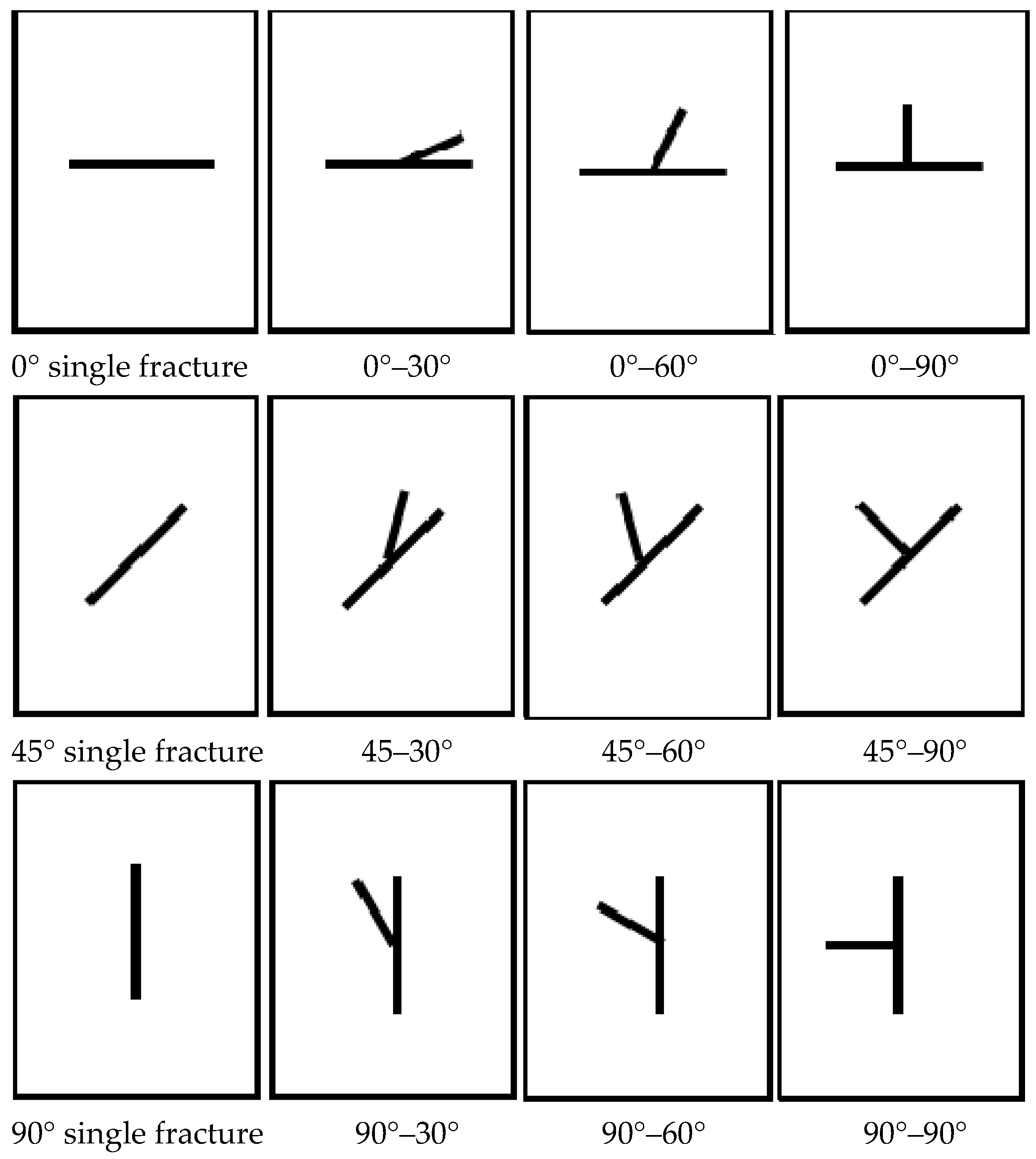
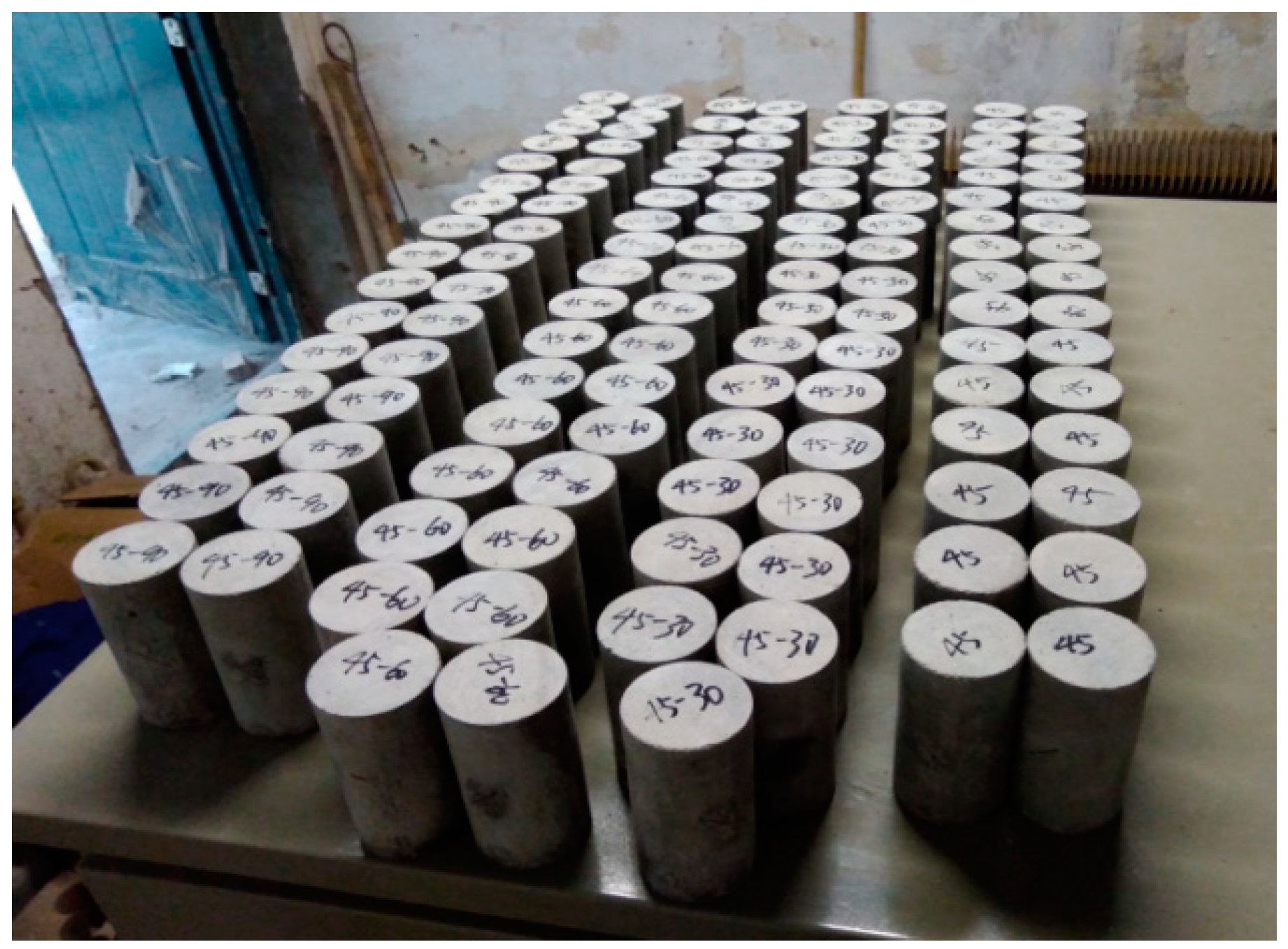

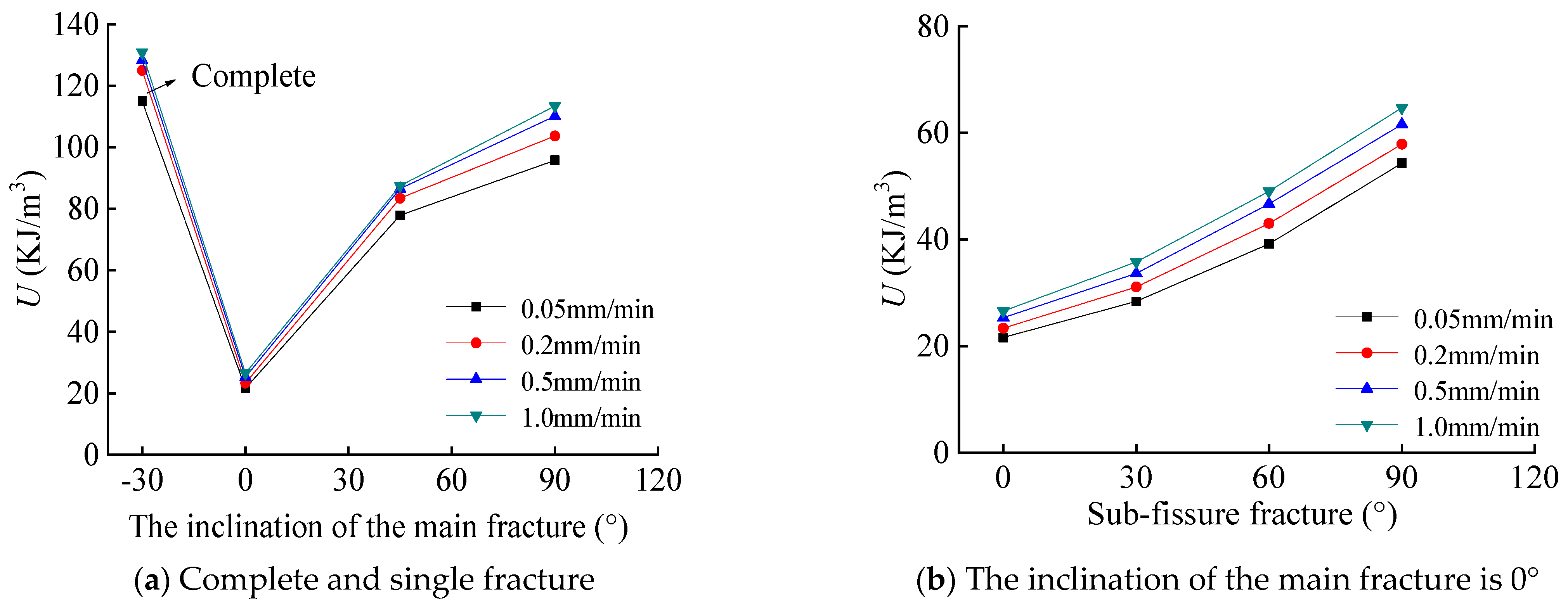

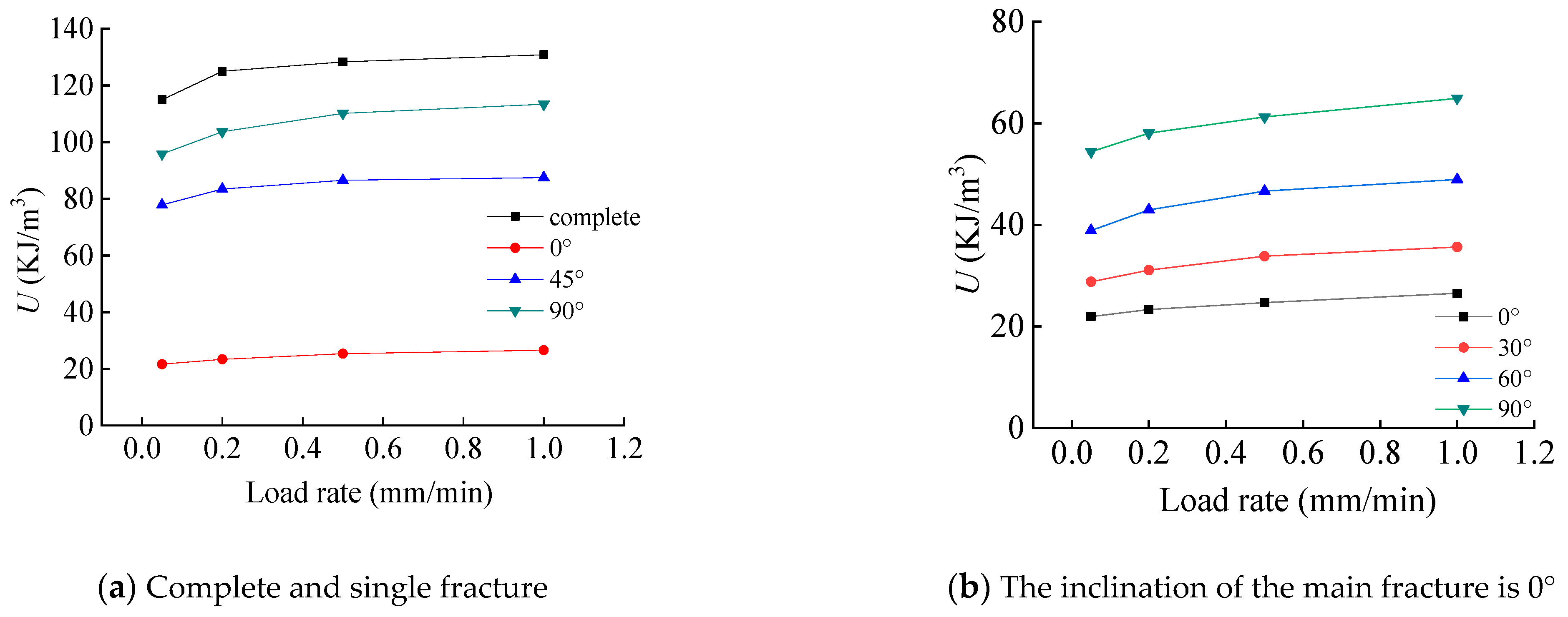
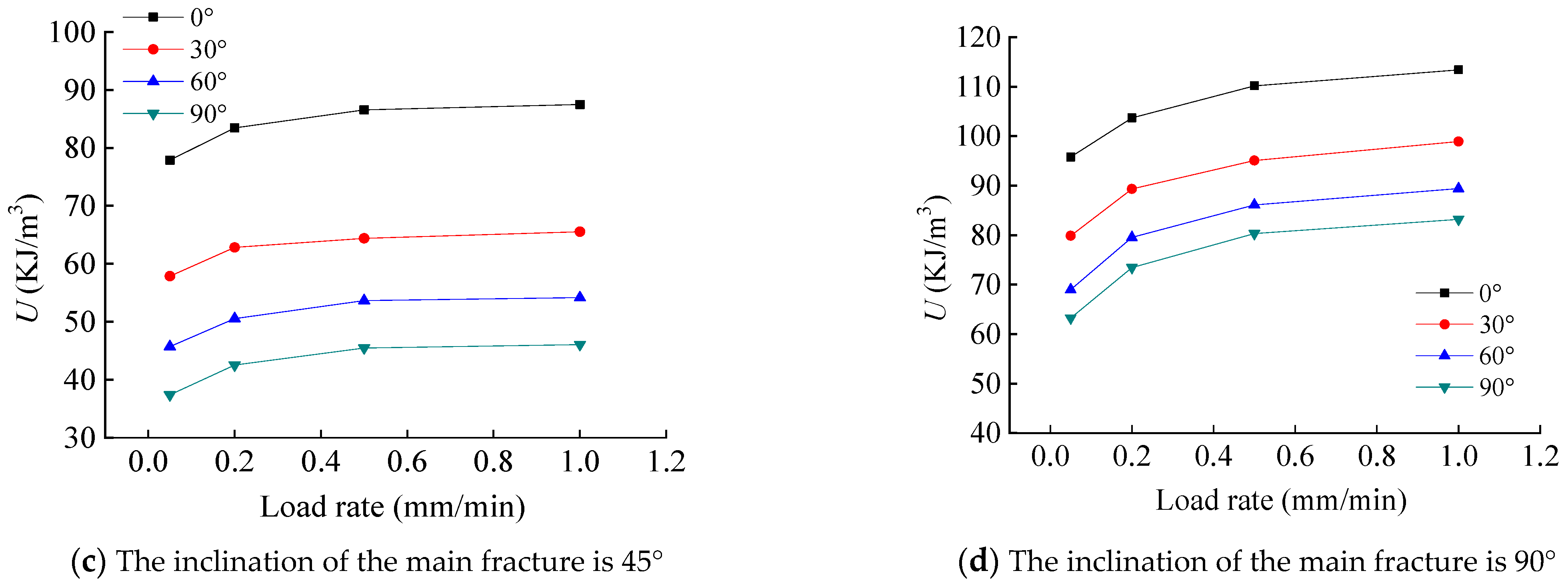
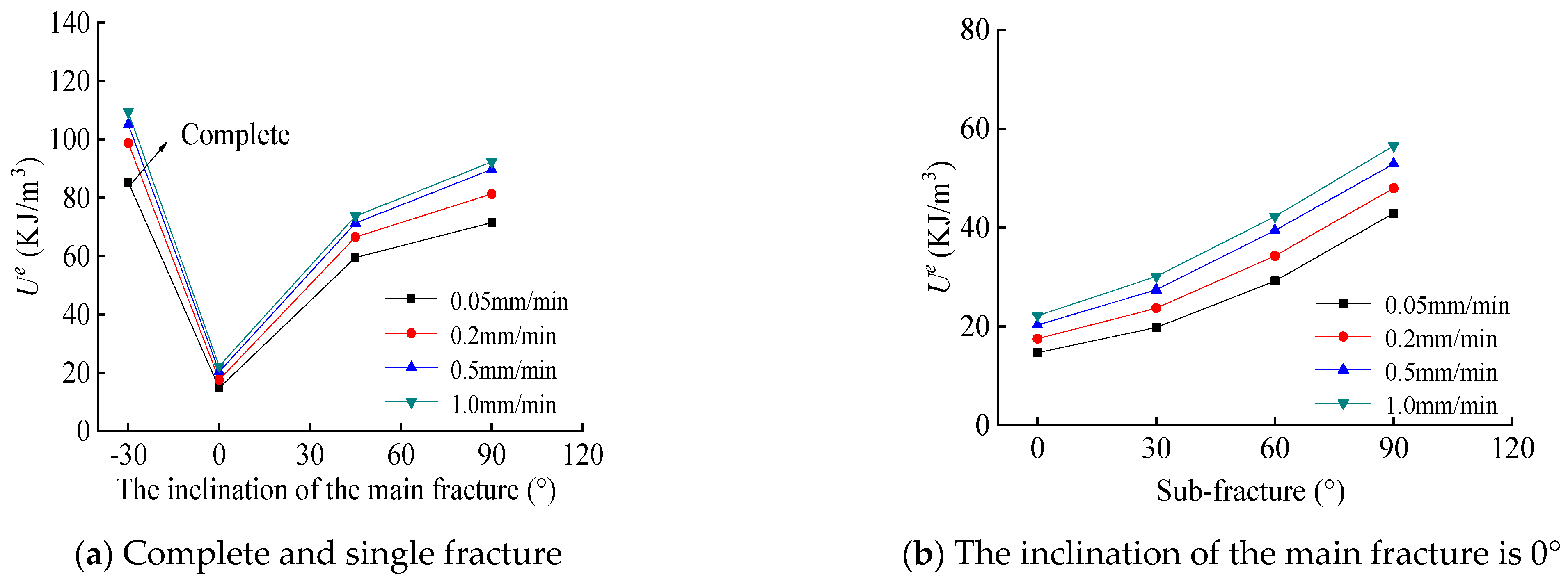
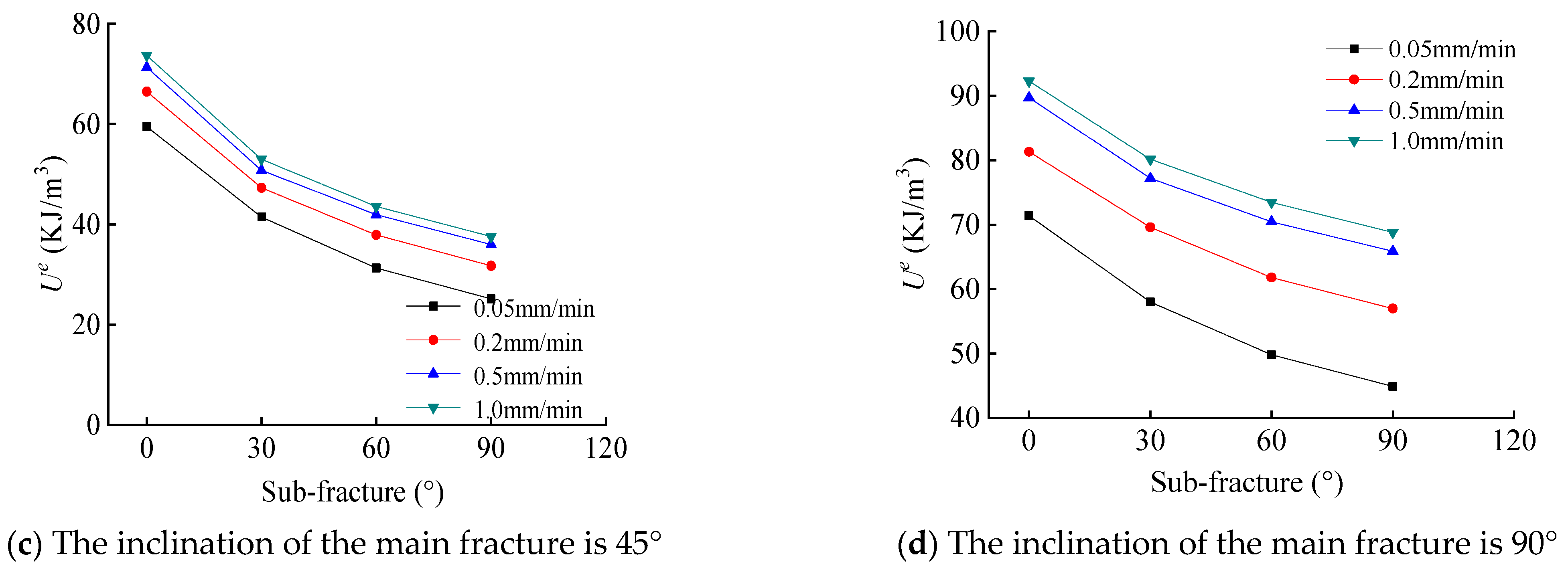
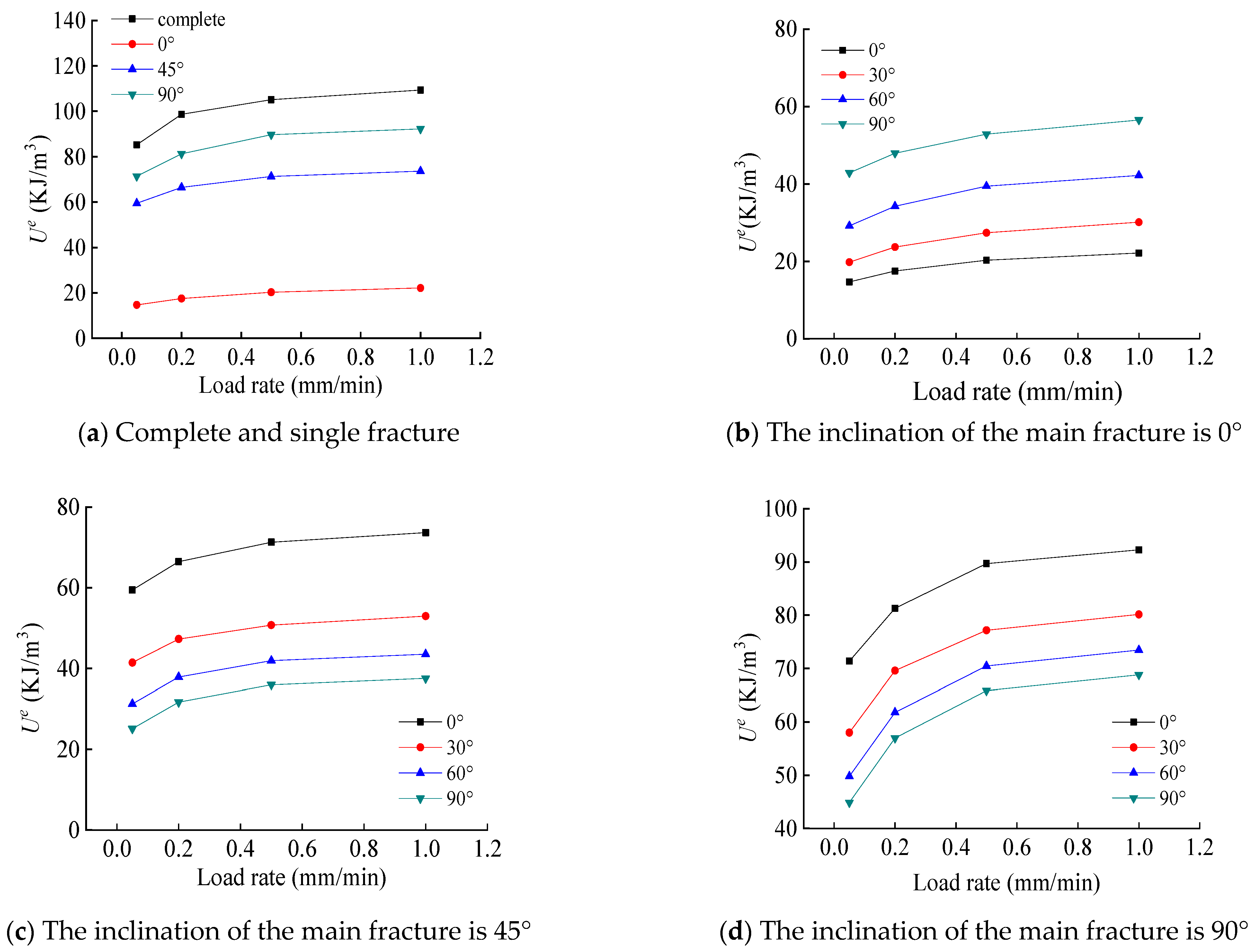
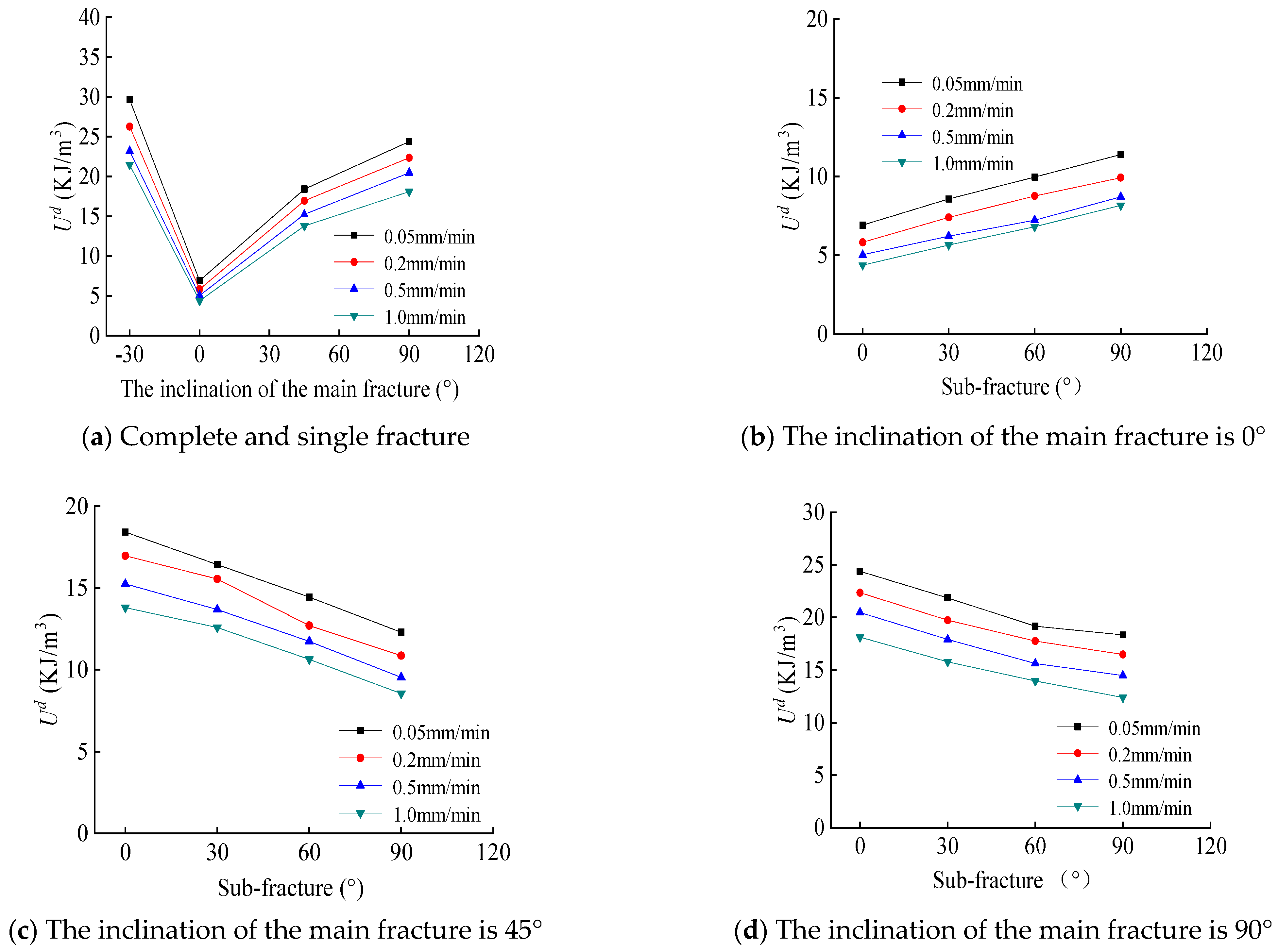

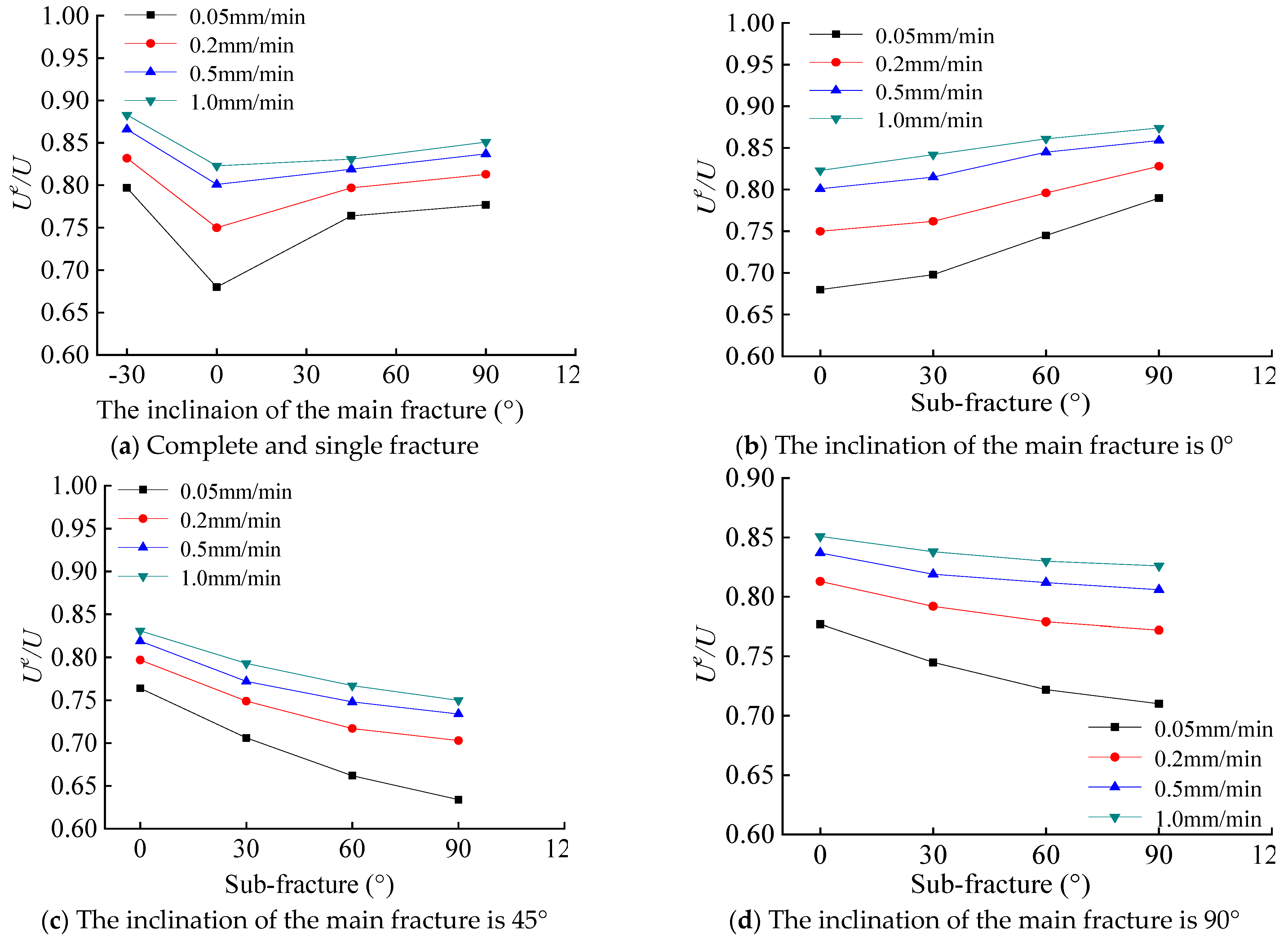
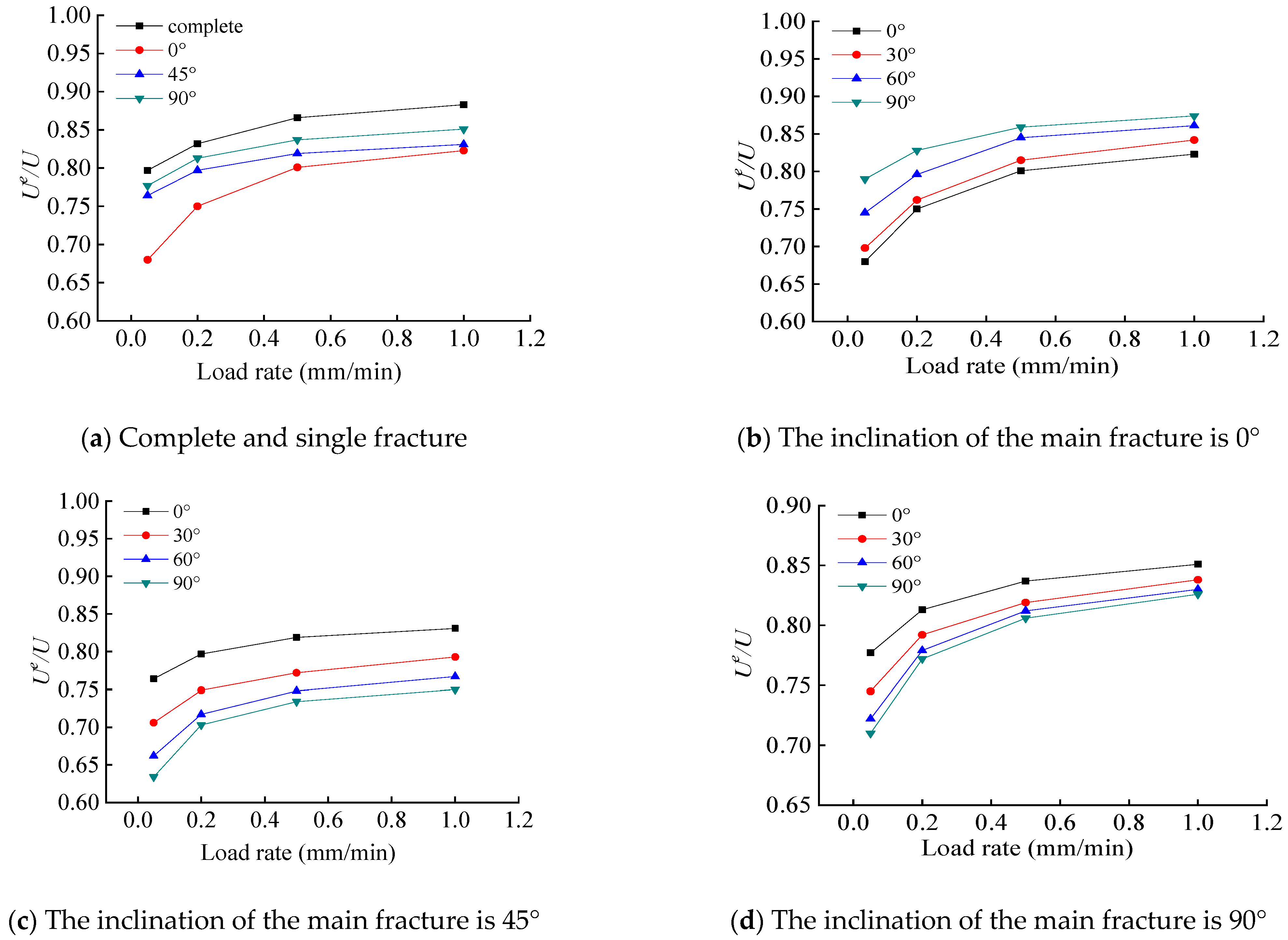

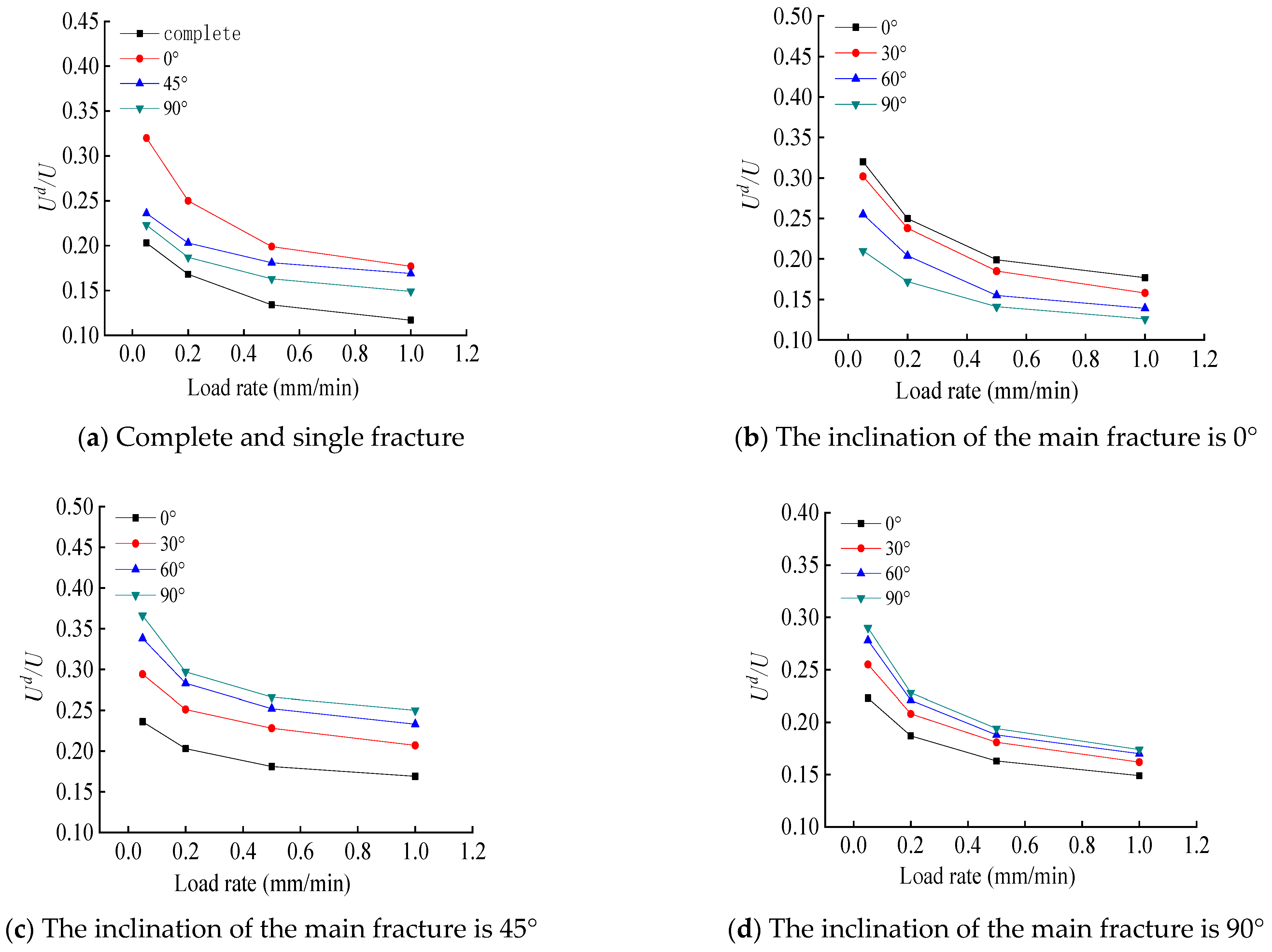
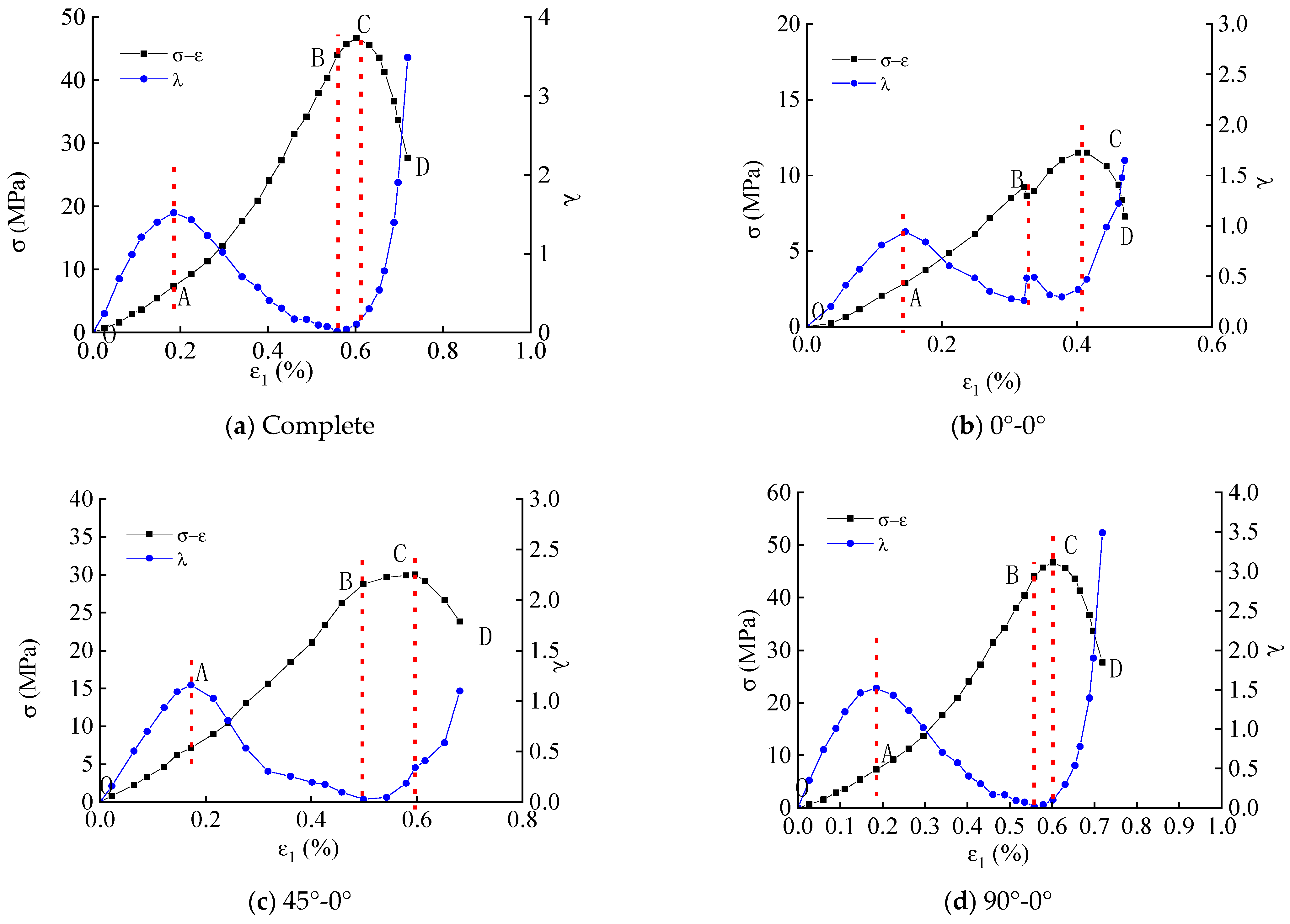
| Specimen Type | Loading Scheme | |
|---|---|---|
| Loading Methods | Loading Rate (mm/min) | |
| Complete specimen | Uniaxial compression test Uniaxial step loading and unloading experiment | 0.05 |
| 0.2 | ||
| 0.5 | ||
| 1 | ||
| Fracture specimen | Uniaxial compression test Uniaxial step loading and unloading experiment | 0.05 |
| 0.2 | ||
| 0.5 | ||
| 1 | ||
Disclaimer/Publisher’s Note: The statements, opinions and data contained in all publications are solely those of the individual author(s) and contributor(s) and not of MDPI and/or the editor(s). MDPI and/or the editor(s) disclaim responsibility for any injury to people or property resulting from any ideas, methods, instructions or products referred to in the content. |
© 2023 by the authors. Licensee MDPI, Basel, Switzerland. This article is an open access article distributed under the terms and conditions of the Creative Commons Attribution (CC BY) license (https://creativecommons.org/licenses/by/4.0/).
Share and Cite
Zhang, Y.; Zhong, L.; Pang, F.; Li, P.; Liu, F. Characteristics of Energy Dissipation in T-Shaped Fractured Rocks under Different Loading Rates. Sustainability 2023, 15, 13695. https://doi.org/10.3390/su151813695
Zhang Y, Zhong L, Pang F, Li P, Liu F. Characteristics of Energy Dissipation in T-Shaped Fractured Rocks under Different Loading Rates. Sustainability. 2023; 15(18):13695. https://doi.org/10.3390/su151813695
Chicago/Turabian StyleZhang, Yong, Lijia Zhong, Fan Pang, Peng Li, and Fengyin Liu. 2023. "Characteristics of Energy Dissipation in T-Shaped Fractured Rocks under Different Loading Rates" Sustainability 15, no. 18: 13695. https://doi.org/10.3390/su151813695





